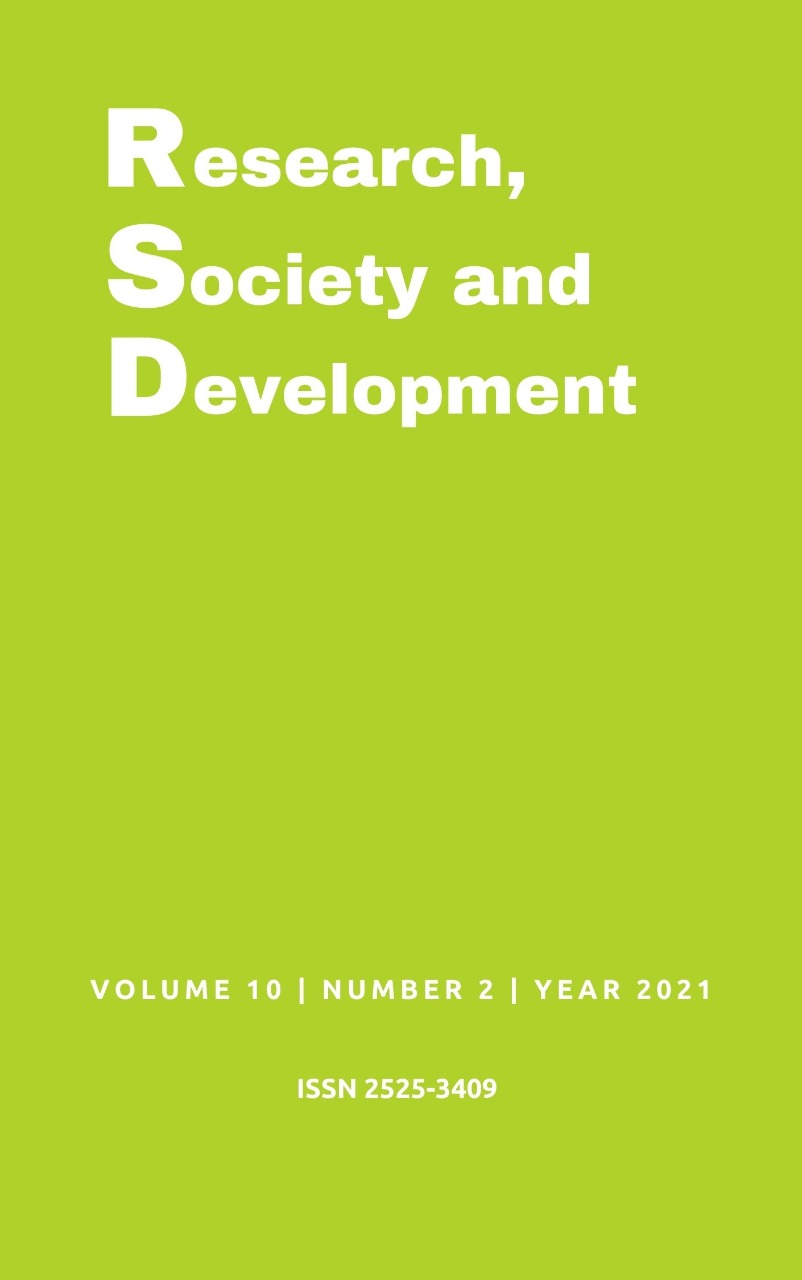Correlação entre a alteração da microbiota gastrintestinal com o surgimento e complicações na doença de Parkinson: papel de citocinas inflamatórias no eixo bidirecional intestino-cérebro
DOI:
https://doi.org/10.33448/rsd-v10i2.12788Palavras-chave:
Microbiota; Doença de Parkinson; Neurodegeneração; Inflamação; Citocinas.Resumo
Os seres humanos desenvolveram uma relação simbiótica com sua microbiota intestinal, uma comunidade microbiana complexa composta de bactérias, archaea, protistas e vírus, incluindo bacteriófagos. O sistema nervoso entérico (SNE) é uma porta de entrada para a comunicação bidirecional entre o cérebro e o intestino, principalmente através do nervo vago (VN). Portanto, a exposição ambiental desempenha um papel fundamental tanto na composição quanto na funcionalidade do microbioma intestinal, e pode contribuir para a suscetibilidade a distúrbios neurodegenerativos, como a doença de Parkinson (DP). Trata-se de uma revisão sistemática de literatura onde foram utilizadas as bases de dados PUBMED, Scielo e MEDLINE, usando os descritores presentes nos Descritores em Ciências da Saúde (DeCS): doença de Parkinson, citocinas, microbiota e trato gastrintestinal. Pode-se mencionar que a característica neuropatológica da DP é a aparência generalizada de agregados de alfa-sinucleína (α-Syn) nos sistemas nervoso central e periférico, incluindo o SNE. Muitos estudos sugerem que as toxinas intestinais podem induzir a formação de agregados α-Syn no SNE, que pode então ser transmitidos para o SNC através do VN. A DP está fortemente associada ao envelhecimento e seus efeitos negativos nos mecanismos homeostáticos que protegem da inflamação, do estresse oxidativo e do mau funcionamento proteico. Dessa forma, o referido estudo pretende realizar, a partir de análises das citocinas inflamatórias e da microbiota intestinal, como uma disbiose pode contribuir no surgimento ou complicações da DP, promovendo uma correlação de manifestações clínico-laboratoriais e prognósticos, bem como descrever os principais mecanismos causais que ainda são poucos compreendidos.
Referências
Camacho-Soto, A., Gross, A., Nielsen, S. S., Dey, N., & Racette, B. A. (2018). Inflammatory bowel disease and risk of Parkinson's disease in Medicare beneficiaries. Parkinsonism & related disorders, 50, 23-28.
Darby, T. M., Owens, J. A., Saeedi, B. J., Luo, L., Matthews, J. D., Robinson, B. S., ... & Jones, R. M. (2019). Lactococcus Lactis Subsp. cremoris is an efficacious beneficial bacterium that limits tissue injury in the intestine. Iscience, 12, 356-367.
Gazerani, P. (2019). Probiotics for Parkinson’s disease. International journal of molecular sciences, 20(17), 4121.
Gogokhia, L., Buhrke, K., Bell, R., Hoffman, B., Brown, D. G., Hanke-Gogokhia, C., ... & Round, J. L. (2019). Expansion of bacteriophages is linked to aggravated intestinal inflammation and colitis. Cell host & microbe, 25(2), 285-299.
Gründemann, J., Schlaudraff, F., Haeckel, O., & Liss, B. (2008). Elevated α-synuclein mRNA levels in individual UV-laser-microdissected dopaminergic substantia nigra neurons in idiopathic Parkinson's disease. Nucleic acids research, 36(7), e38.
Hasegawa, S., Goto, S., Tsuji, H., Okuno, T., Asahara, T., Nomoto, K., ... & Hirayama, M. (2015). Intestinal dysbiosis and lowered serum lipopolysaccharide-binding protein in Parkinson’s disease. PloS one, 10(11), e0142164.
Kim, D. S., Choi, H. I., Wang, Y., Luo, Y., Hoffer, B. J., & Greig, N. H. (2017). A new treatment strategy for Parkinson's disease through the gut–brain axis: the glucagon-like peptide-1 receptor pathway. Cell transplantation, 26(9), 1560-1571.
Lee, H. S., Lobbestael, E., Vermeire, S., Sabino, J., & Cleynen, I. (2021). Inflammatory bowel disease and Parkinson’s disease: common pathophysiological links. Gut, 70(2), 408-417.
Miraglia, F., & Colla, E. (2019). Microbiome, Parkinson’s disease and molecular mimicry. Cells, 8(3), 222.
Neurath, M. F. (2014). Cytokines in inflammatory bowel disease. Nature Reviews Immunology, 14(5), 329-342.
Pereira, A. S., Shitsuka, D. M., Parreira, F. J., & Shitsuka, R. (2018). Metodologia da pesquisa científica.
Radhakrishnan, D. M., & Goyal, V. (2018). Parkinson's disease: A review. Neurology India, 66(7), 26.
Santos, S. F., De Oliveira, H. L., Yamada, E. S., Neves, B. C., & Pereira Jr, A. (2019). The gut and Parkinson's Disease—a bidirectional pathway. Frontiers in neurology, 10, 574.
Souza, C. F. M., Almeida, H. C. P., Sousa, J. B., Costa, P. H., Silveira, Y. S. S., & Bezerra, J. C. L. (2011). A doença de parkinson e o processo de envelhecimento motor. Revista Neurociências, 19(4), 718-723.
Stefanis, L. (2012). α-Synuclein in Parkinson's disease. Cold Spring Harbor perspectives in medicine, 2(2), a009399.
Strandwitz, P., Kim, K. H., Terekhova, D., Liu, J. K., Sharma, A., Levering, J., ... & Lewis, K. (2019). GABA-modulating bacteria of the human gut microbiota. Nature microbiology, 4(3), 396-403.
Tysnes OB, Storstein A. Epidemiology of Parkinson's disease (2017). J Neural Transm. 124 (8), 901-905.
Downloads
Publicado
Como Citar
Edição
Seção
Licença
Copyright (c) 2021 Pablo Cleber Sousa Lopes Sales; Almir Vieira de Sousa Neto; Lahuan Araujo Costa; Mikhail de Morais Veras da Fonseca; Gabriela de Souza Mendonça; Ligia Viana de Araújo; Vitória Stefanny Cunha Araújo; Ana Maria Santos Cardoso; Paulo Victor de Sousa Jordão; Brenda Dias Araujo; Charles Ponte de Sousa Filho; Louise Ribeiro Teixeira; José Guilherme de Oliveira Rodrigues Ferreira ; Rafaela Costa Pacheco; André Pessoa Silva Bastos; Brenda Ellen Meneses Cardoso; Larruama Soares Figueiredo de Araújo; Bianca Sampaio Lima; Vivian Saeger Pires; Luan Kelves Miranda de Souza

Este trabalho está licenciado sob uma licença Creative Commons Attribution 4.0 International License.
Autores que publicam nesta revista concordam com os seguintes termos:
1) Autores mantém os direitos autorais e concedem à revista o direito de primeira publicação, com o trabalho simultaneamente licenciado sob a Licença Creative Commons Attribution que permite o compartilhamento do trabalho com reconhecimento da autoria e publicação inicial nesta revista.
2) Autores têm autorização para assumir contratos adicionais separadamente, para distribuição não-exclusiva da versão do trabalho publicada nesta revista (ex.: publicar em repositório institucional ou como capítulo de livro), com reconhecimento de autoria e publicação inicial nesta revista.
3) Autores têm permissão e são estimulados a publicar e distribuir seu trabalho online (ex.: em repositórios institucionais ou na sua página pessoal) a qualquer ponto antes ou durante o processo editorial, já que isso pode gerar alterações produtivas, bem como aumentar o impacto e a citação do trabalho publicado.

